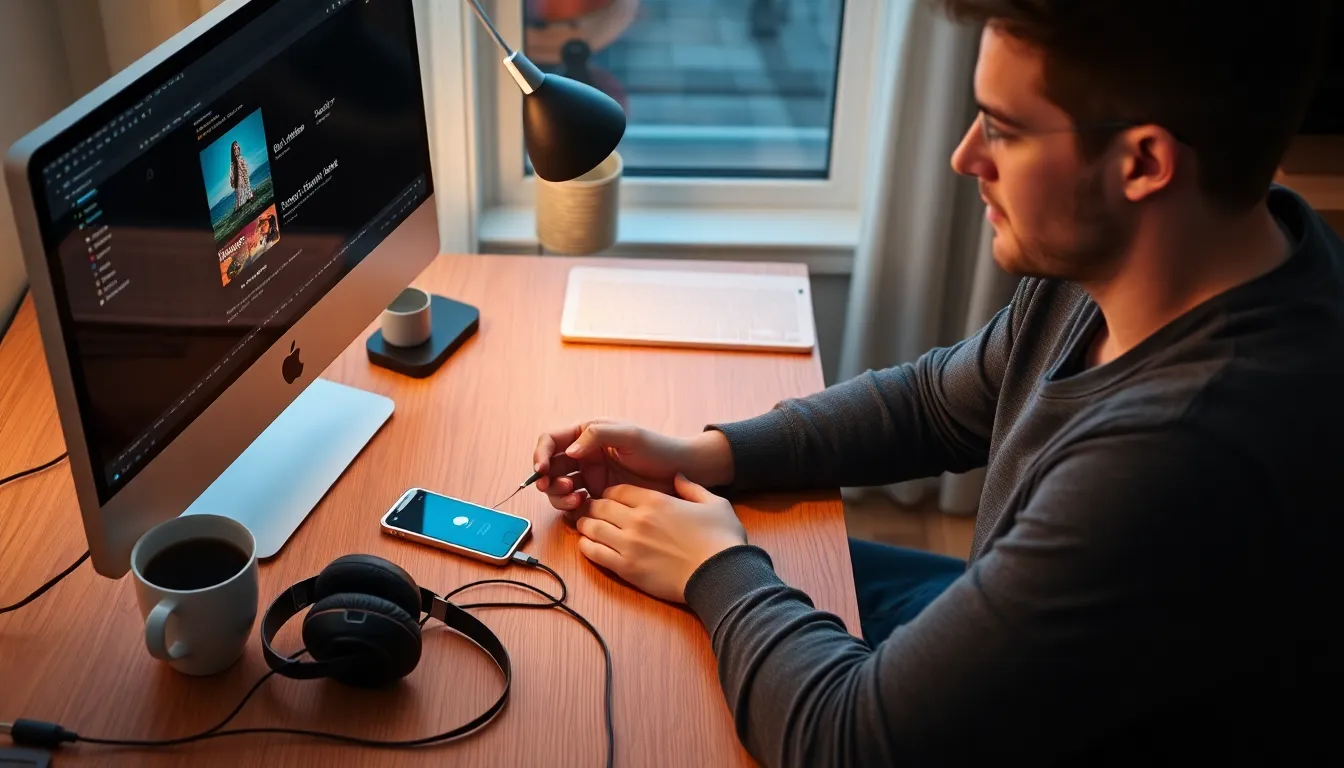Ever found yourself jamming to a catchy tune and thought, “I wish I could keep this gem forever”? Well, saving MP3s on an iPhone isn’t just a dream; it’s a reality waiting for you to grab it! Imagine having your favorite tracks at your fingertips, ready to accompany you on those long commutes or while you’re pretending to work out.
Table of Contents
ToggleUnderstanding MP3 Files
MP3 files serve as a popular audio format, allowing users to store music efficiently. This file type compresses audio data without significantly diminishing quality, making it ideal for portable devices.
What Are MP3 Files?
MP3 files, short for MPEG Audio Layer III, store digital audio in a compressed format. They reduce file size while retaining sound quality, appealing to music lovers who seek storage efficiency. Their widespread compatibility with devices enhances usability, enabling playback across various platforms. Most music streaming applications also support this format, allowing easy downloads and sharing among users.
Why Save MP3 on iPhone?
Saving MP3s on an iPhone offers multiple advantages. Access to favorite songs becomes simple during commutes or workouts, providing personalized entertainment. Offline listening eliminates the need for an internet connection, adding convenience when in areas with limited service. Users can create custom playlists, organizing music based on mood or occasions, enhancing their listening experience. This flexibility makes it easy to enjoy music anytime, anywhere.
Methods to Save MP3 on iPhone

Several methods exist for saving MP3 files on an iPhone, ensuring access to favorite tunes anytime. Each method varies by ease and effectiveness.
Using iTunes
iTunes provides a traditional way to transfer MP3 files to an iPhone. First, launch iTunes on a computer and connect the iPhone using a USB cable. After selecting the device, click on the “Music” tab and check the “Sync Music” option. Choose either specific songs or entire libraries before clicking “Apply” to initiate the transfer. This method allows users to manage music libraries efficiently, syncing new tracks seamlessly.
Using Third-Party Apps
Numerous third-party apps facilitate MP3 downloads directly on an iPhone. Applications such as Documents by Readdle and My Files support file management and audio playback. Users download MP3 files from various sources and save them within these apps. Some apps may even allow background playback or create playlists for easy access, making music listening more enjoyable.
Direct Download from Websites
Downloading MP3s directly from websites offers a direct approach to file access. Certain music download platforms permit users to save MP3 files straight to their devices. Many websites enable this via simple download buttons, requiring minimal steps. Users benefit from quick access to songs, enhancing their music library without needing a computer.
Managing MP3 Files on iPhone
Managing MP3 files on an iPhone enhances music enjoyment and accessibility. Proper organization and playlist creation streamline the listening experience.
Organizing Your Music Library
Organizing a music library involves a few simple strategies. Users can create folders to categorize music by genre or artist. Sorting MP3 files helps access favorite tracks quickly. Many individuals find it useful to rename files for easy identification. Additionally, syncing with iTunes allows users to maintain a well-structured library. Keeping playlists updated ensures that every listening session feels fresh.
Creating Playlists
Creating playlists offers a personalized way to enjoy music. Start by selecting favorite MP3 files for a specific mood or activity. Users can combine various genres to match workout intensities. Naming playlists appropriately aids in recalling their purpose. Adding or removing songs keeps playlists dynamic. Sharing playlists with friends can enhance social interaction around music choices. Apps like Apple Music streamline this process with user-friendly interfaces.
Troubleshooting Common Issues
Users may encounter a few typical problems when saving MP3 files on an iPhone. Addressing these issues can enhance the experience and ensure smooth playback.
Syncing Problems
Often, syncing MP3 files from iTunes faces challenges. Check the USB connection first; it must be secure for successful transfers. Users sometimes forget to authorize the computer. Ensuring the computer is authorized under the iTunes account resolves many syncing issues. Additionally, outdated software can hinder performance. Users should ensure both iTunes and iOS versions are current. Checking storage space also proves vital; insufficient space impacts file transfers significantly.
Playback Issues
Playback problems can arise unexpectedly during MP3 enjoyment. When audio files don’t play, verifying the file format is crucial. MP3 files must be properly formatted for iPhone compatibility. Restarting the music app often resolves temporary glitches. If sound issues persist, adjusting the volume settings or checking for headphone connections may help. Users might also consider resetting settings on their device if the playback problem continues. This action can restore functionality and enhance overall performance.
Saving MP3 files on an iPhone opens up a world of musical possibilities. With easy access to favorite tracks users can enjoy their music anytime and anywhere. The various methods discussed provide flexibility whether through iTunes third-party apps or direct downloads.
By managing and organizing their music libraries effectively users can enhance their listening experience and create personalized playlists that fit their lifestyles. Troubleshooting common issues ensures smooth playback and a seamless experience.
With these strategies in hand anyone can transform their iPhone into a portable music hub ready for any occasion.




